SWK 509: Analysis of Research Design in Child Abuse Prevention Program
VerifiedAdded on 2022/09/28
|11
|2842
|23
Report
AI Summary
This report provides a critical analysis of a research design for a child abuse prevention program in South Africa, focusing on a pre-post pilot study involving 30 dyads of children and caregivers. The study aimed to evaluate the effectiveness of parenting support interventions in reducing adolescent behavioral problems and preventing child abuse. The report identifies strengths, such as the use of ethical protocols and validated questionnaires, while highlighting weaknesses like selection bias, small sample size, and lack of a control group, which threaten the internal validity. The report proposes an experimental research design as a more robust alternative, emphasizing the importance of random stratification, larger sample sizes, and culturally appropriate measures. It also recommends longer-term follow-ups and the inclusion of diverse ethnic groups and settings to strengthen the research and address child abuse effectively in the sub-Saharan African context. The analysis emphasizes the need for united research efforts involving local researchers and the development of reliable and culturally sensitive assessment tools.
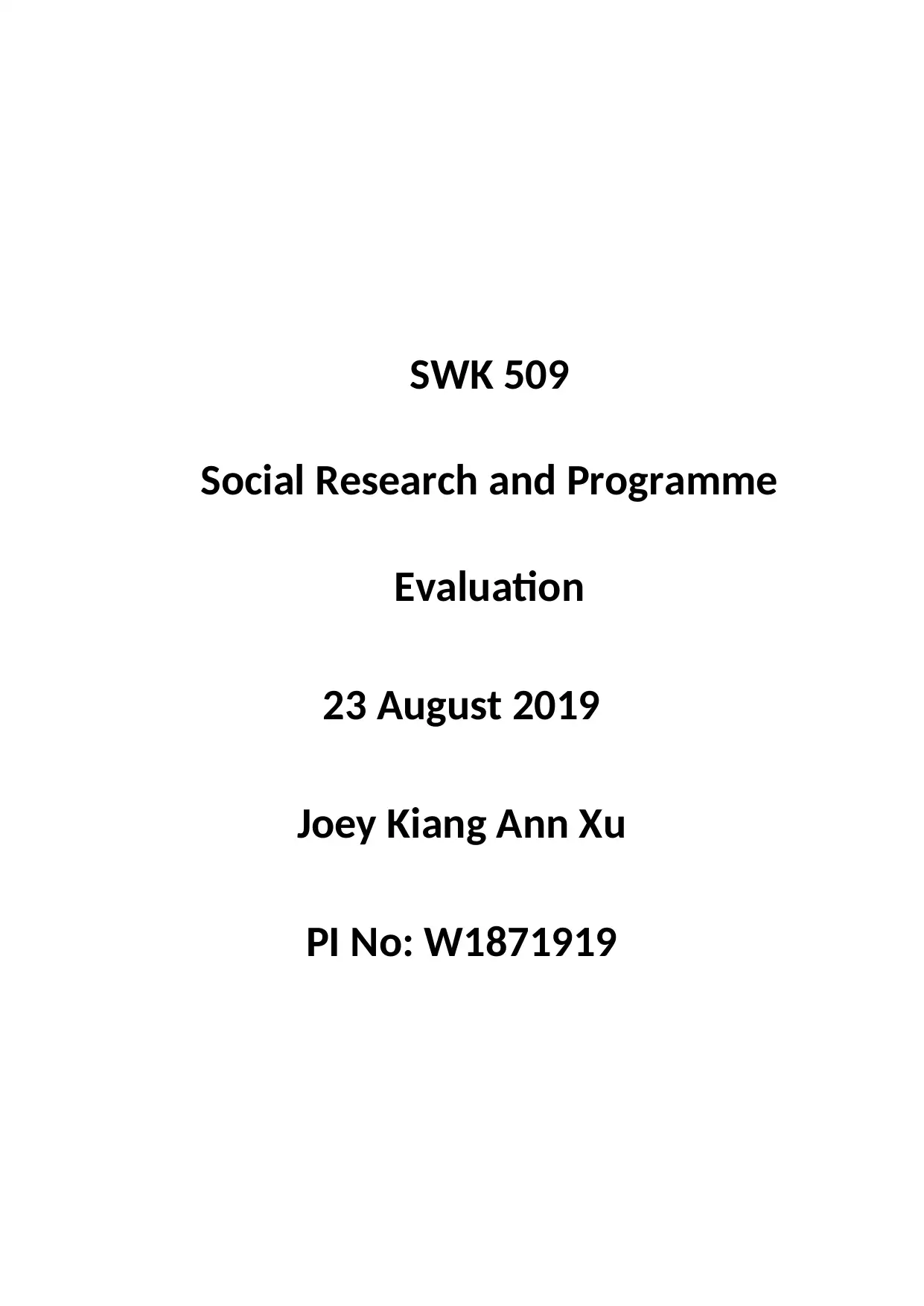
SWK 509
Social Research and Programme
Evaluation
23 August 2019
Joey Kiang Ann Xu
PI No: W1871919
Social Research and Programme
Evaluation
23 August 2019
Joey Kiang Ann Xu
PI No: W1871919
Paraphrase This Document
Need a fresh take? Get an instant paraphrase of this document with our AI Paraphraser
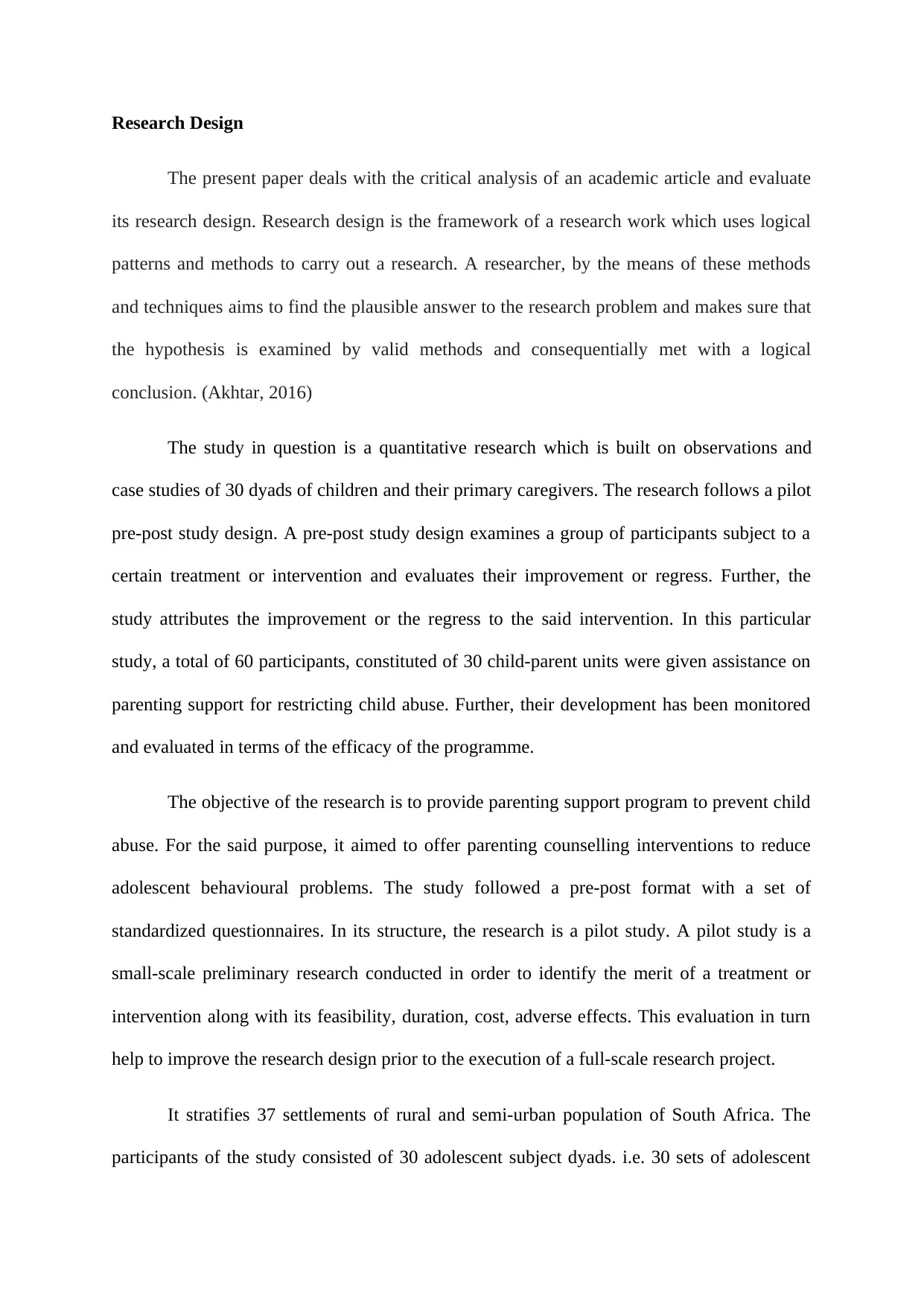
Research Design
The present paper deals with the critical analysis of an academic article and evaluate
its research design. Research design is the framework of a research work which uses logical
patterns and methods to carry out a research. A researcher, by the means of these methods
and techniques aims to find the plausible answer to the research problem and makes sure that
the hypothesis is examined by valid methods and consequentially met with a logical
conclusion. (Akhtar, 2016)
The study in question is a quantitative research which is built on observations and
case studies of 30 dyads of children and their primary caregivers. The research follows a pilot
pre-post study design. A pre-post study design examines a group of participants subject to a
certain treatment or intervention and evaluates their improvement or regress. Further, the
study attributes the improvement or the regress to the said intervention. In this particular
study, a total of 60 participants, constituted of 30 child-parent units were given assistance on
parenting support for restricting child abuse. Further, their development has been monitored
and evaluated in terms of the efficacy of the programme.
The objective of the research is to provide parenting support program to prevent child
abuse. For the said purpose, it aimed to offer parenting counselling interventions to reduce
adolescent behavioural problems. The study followed a pre-post format with a set of
standardized questionnaires. In its structure, the research is a pilot study. A pilot study is a
small-scale preliminary research conducted in order to identify the merit of a treatment or
intervention along with its feasibility, duration, cost, adverse effects. This evaluation in turn
help to improve the research design prior to the execution of a full-scale research project.
It stratifies 37 settlements of rural and semi-urban population of South Africa. The
participants of the study consisted of 30 adolescent subject dyads. i.e. 30 sets of adolescent
The present paper deals with the critical analysis of an academic article and evaluate
its research design. Research design is the framework of a research work which uses logical
patterns and methods to carry out a research. A researcher, by the means of these methods
and techniques aims to find the plausible answer to the research problem and makes sure that
the hypothesis is examined by valid methods and consequentially met with a logical
conclusion. (Akhtar, 2016)
The study in question is a quantitative research which is built on observations and
case studies of 30 dyads of children and their primary caregivers. The research follows a pilot
pre-post study design. A pre-post study design examines a group of participants subject to a
certain treatment or intervention and evaluates their improvement or regress. Further, the
study attributes the improvement or the regress to the said intervention. In this particular
study, a total of 60 participants, constituted of 30 child-parent units were given assistance on
parenting support for restricting child abuse. Further, their development has been monitored
and evaluated in terms of the efficacy of the programme.
The objective of the research is to provide parenting support program to prevent child
abuse. For the said purpose, it aimed to offer parenting counselling interventions to reduce
adolescent behavioural problems. The study followed a pre-post format with a set of
standardized questionnaires. In its structure, the research is a pilot study. A pilot study is a
small-scale preliminary research conducted in order to identify the merit of a treatment or
intervention along with its feasibility, duration, cost, adverse effects. This evaluation in turn
help to improve the research design prior to the execution of a full-scale research project.
It stratifies 37 settlements of rural and semi-urban population of South Africa. The
participants of the study consisted of 30 adolescent subject dyads. i.e. 30 sets of adolescent

children and their caregivers. The adolescents were aged between 10 to 17 years. The subject
sets were residents of two particular locations of Eastern Cape Province in South Africa and
belonged to high-poverty stratum. This non-variance of the sample is a threat to the research
outcome. Moreover, what may cause more obstruction in terms of an accurate research
outcome is the small sampling size. The study involved 60 subjects that included cases of
child abuse as well as child behavioural issues, the small sampling size effectively hampered
the randomization of the research.
Research Bias
The research method involves a selection bias. Selection bias is a form of threat that
restricts the internal validity of an academic research. To elucidate, the study was conducted
involving adolescent individuals and their primary caregivers. The sampling included only
one group of subjects and has no scope of comparison with any other test group. Thus, it is
hampering the internal validity of the research as it has no control groups and consequentially
it affects the randomization.
The previous researches in the same problem area, namely parenting support in the
context of child abuse, were conducted in the high-income economy countries. In contrast to
that design, the research should have adopted a more random stratification in sampling.
Besides, the study includes children with issues like mental health etc. in the study
population, which may influence the outcome in the form of statistical regression. Thus, the
research involves a selection bias towards the outcome, as these factors may affect the
standardisation of the causality. Moreover, the researchers themselves admit that they were
not confident about the testing methods themselves, which is evidently reflected as a negative
impact on one of the adolescent report of abuse as found in the study.
sets were residents of two particular locations of Eastern Cape Province in South Africa and
belonged to high-poverty stratum. This non-variance of the sample is a threat to the research
outcome. Moreover, what may cause more obstruction in terms of an accurate research
outcome is the small sampling size. The study involved 60 subjects that included cases of
child abuse as well as child behavioural issues, the small sampling size effectively hampered
the randomization of the research.
Research Bias
The research method involves a selection bias. Selection bias is a form of threat that
restricts the internal validity of an academic research. To elucidate, the study was conducted
involving adolescent individuals and their primary caregivers. The sampling included only
one group of subjects and has no scope of comparison with any other test group. Thus, it is
hampering the internal validity of the research as it has no control groups and consequentially
it affects the randomization.
The previous researches in the same problem area, namely parenting support in the
context of child abuse, were conducted in the high-income economy countries. In contrast to
that design, the research should have adopted a more random stratification in sampling.
Besides, the study includes children with issues like mental health etc. in the study
population, which may influence the outcome in the form of statistical regression. Thus, the
research involves a selection bias towards the outcome, as these factors may affect the
standardisation of the causality. Moreover, the researchers themselves admit that they were
not confident about the testing methods themselves, which is evidently reflected as a negative
impact on one of the adolescent report of abuse as found in the study.
⊘ This is a preview!⊘
Do you want full access?
Subscribe today to unlock all pages.

Trusted by 1+ million students worldwide
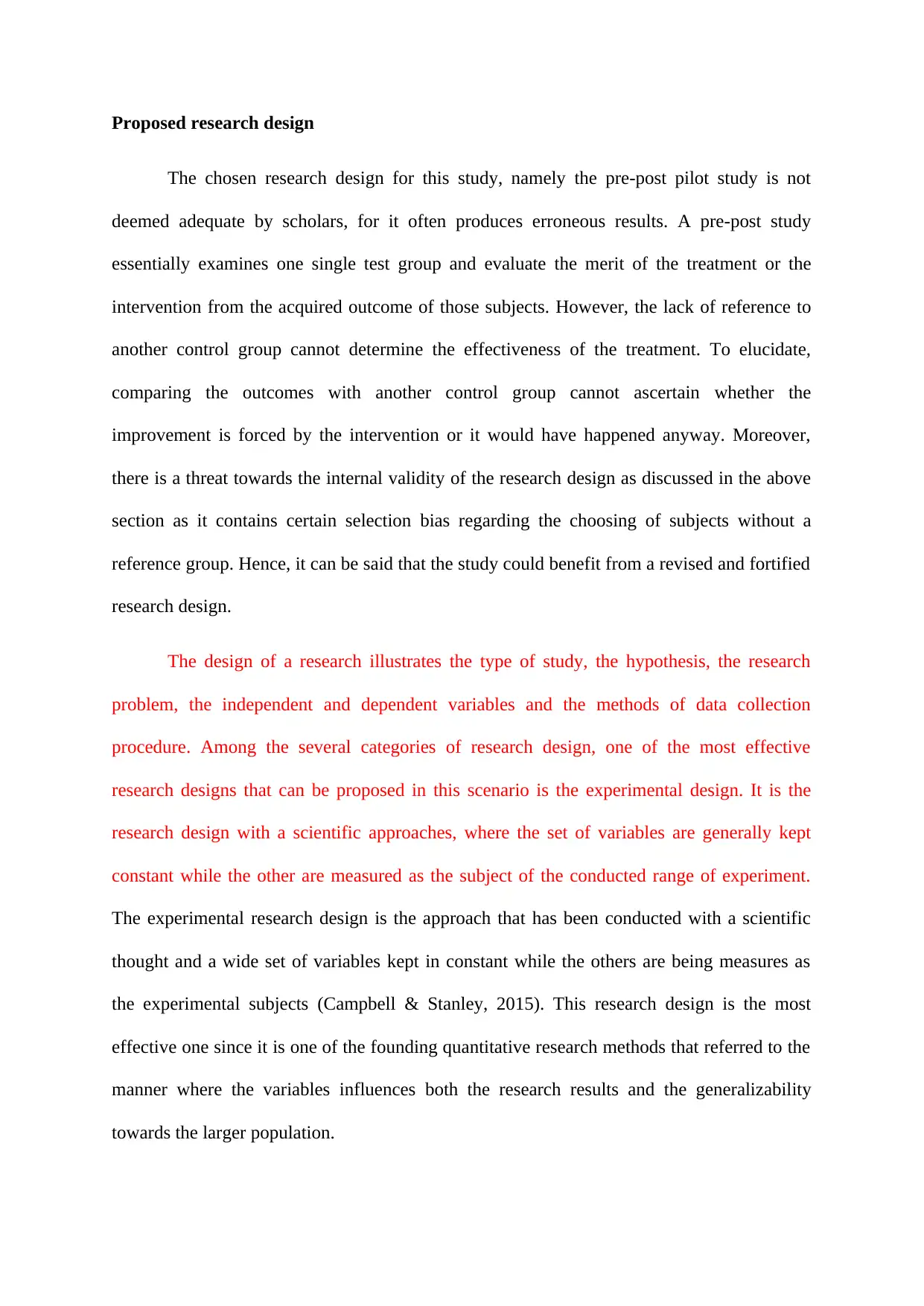
Proposed research design
The chosen research design for this study, namely the pre-post pilot study is not
deemed adequate by scholars, for it often produces erroneous results. A pre-post study
essentially examines one single test group and evaluate the merit of the treatment or the
intervention from the acquired outcome of those subjects. However, the lack of reference to
another control group cannot determine the effectiveness of the treatment. To elucidate,
comparing the outcomes with another control group cannot ascertain whether the
improvement is forced by the intervention or it would have happened anyway. Moreover,
there is a threat towards the internal validity of the research design as discussed in the above
section as it contains certain selection bias regarding the choosing of subjects without a
reference group. Hence, it can be said that the study could benefit from a revised and fortified
research design.
The design of a research illustrates the type of study, the hypothesis, the research
problem, the independent and dependent variables and the methods of data collection
procedure. Among the several categories of research design, one of the most effective
research designs that can be proposed in this scenario is the experimental design. It is the
research design with a scientific approaches, where the set of variables are generally kept
constant while the other are measured as the subject of the conducted range of experiment.
The experimental research design is the approach that has been conducted with a scientific
thought and a wide set of variables kept in constant while the others are being measures as
the experimental subjects (Campbell & Stanley, 2015). This research design is the most
effective one since it is one of the founding quantitative research methods that referred to the
manner where the variables influences both the research results and the generalizability
towards the larger population.
The chosen research design for this study, namely the pre-post pilot study is not
deemed adequate by scholars, for it often produces erroneous results. A pre-post study
essentially examines one single test group and evaluate the merit of the treatment or the
intervention from the acquired outcome of those subjects. However, the lack of reference to
another control group cannot determine the effectiveness of the treatment. To elucidate,
comparing the outcomes with another control group cannot ascertain whether the
improvement is forced by the intervention or it would have happened anyway. Moreover,
there is a threat towards the internal validity of the research design as discussed in the above
section as it contains certain selection bias regarding the choosing of subjects without a
reference group. Hence, it can be said that the study could benefit from a revised and fortified
research design.
The design of a research illustrates the type of study, the hypothesis, the research
problem, the independent and dependent variables and the methods of data collection
procedure. Among the several categories of research design, one of the most effective
research designs that can be proposed in this scenario is the experimental design. It is the
research design with a scientific approaches, where the set of variables are generally kept
constant while the other are measured as the subject of the conducted range of experiment.
The experimental research design is the approach that has been conducted with a scientific
thought and a wide set of variables kept in constant while the others are being measures as
the experimental subjects (Campbell & Stanley, 2015). This research design is the most
effective one since it is one of the founding quantitative research methods that referred to the
manner where the variables influences both the research results and the generalizability
towards the larger population.
Paraphrase This Document
Need a fresh take? Get an instant paraphrase of this document with our AI Paraphraser
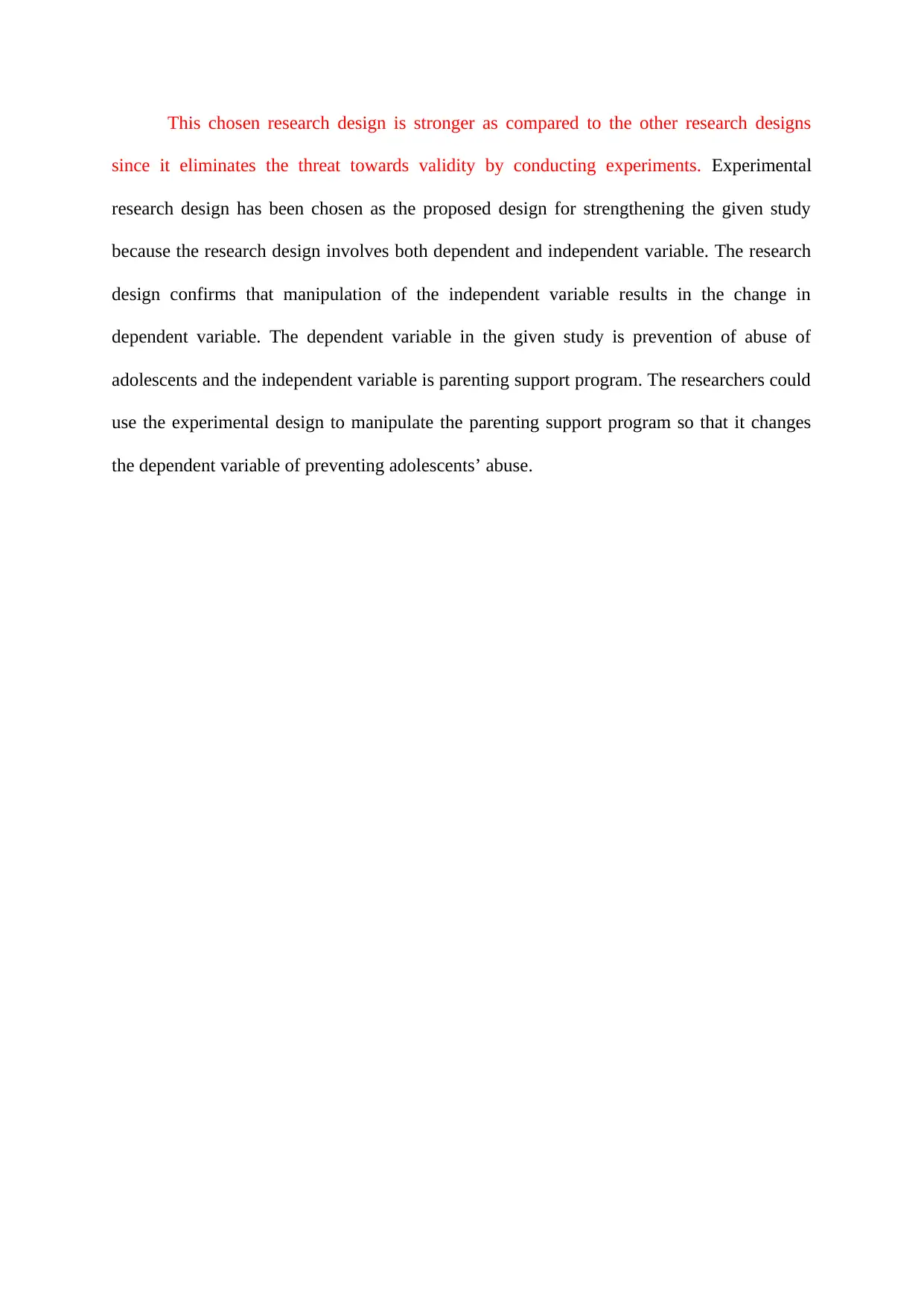
This chosen research design is stronger as compared to the other research designs
since it eliminates the threat towards validity by conducting experiments. Experimental
research design has been chosen as the proposed design for strengthening the given study
because the research design involves both dependent and independent variable. The research
design confirms that manipulation of the independent variable results in the change in
dependent variable. The dependent variable in the given study is prevention of abuse of
adolescents and the independent variable is parenting support program. The researchers could
use the experimental design to manipulate the parenting support program so that it changes
the dependent variable of preventing adolescents’ abuse.
since it eliminates the threat towards validity by conducting experiments. Experimental
research design has been chosen as the proposed design for strengthening the given study
because the research design involves both dependent and independent variable. The research
design confirms that manipulation of the independent variable results in the change in
dependent variable. The dependent variable in the given study is prevention of abuse of
adolescents and the independent variable is parenting support program. The researchers could
use the experimental design to manipulate the parenting support program so that it changes
the dependent variable of preventing adolescents’ abuse.
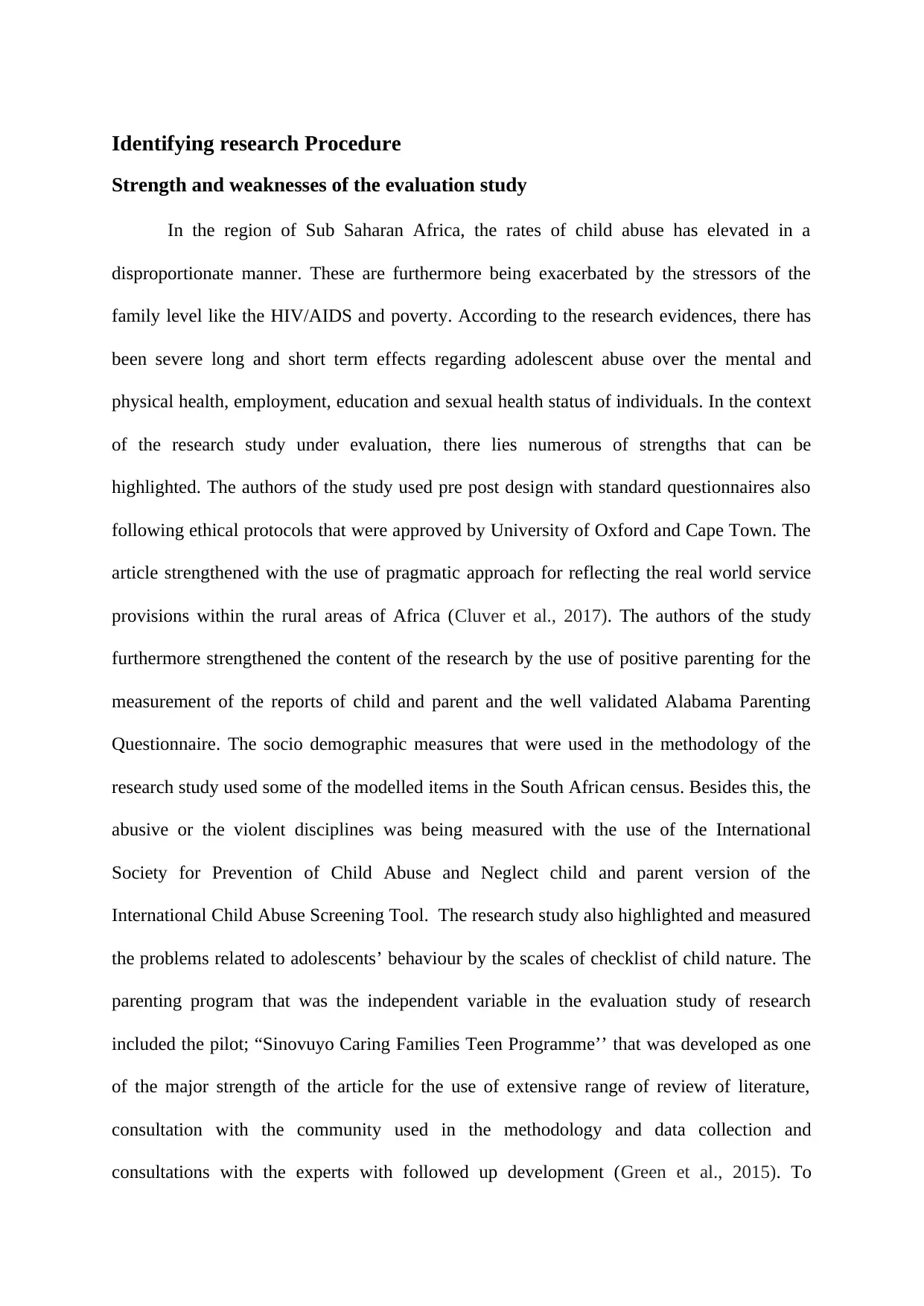
Identifying research Procedure
Strength and weaknesses of the evaluation study
In the region of Sub Saharan Africa, the rates of child abuse has elevated in a
disproportionate manner. These are furthermore being exacerbated by the stressors of the
family level like the HIV/AIDS and poverty. According to the research evidences, there has
been severe long and short term effects regarding adolescent abuse over the mental and
physical health, employment, education and sexual health status of individuals. In the context
of the research study under evaluation, there lies numerous of strengths that can be
highlighted. The authors of the study used pre post design with standard questionnaires also
following ethical protocols that were approved by University of Oxford and Cape Town. The
article strengthened with the use of pragmatic approach for reflecting the real world service
provisions within the rural areas of Africa (Cluver et al., 2017). The authors of the study
furthermore strengthened the content of the research by the use of positive parenting for the
measurement of the reports of child and parent and the well validated Alabama Parenting
Questionnaire. The socio demographic measures that were used in the methodology of the
research study used some of the modelled items in the South African census. Besides this, the
abusive or the violent disciplines was being measured with the use of the International
Society for Prevention of Child Abuse and Neglect child and parent version of the
International Child Abuse Screening Tool. The research study also highlighted and measured
the problems related to adolescents’ behaviour by the scales of checklist of child nature. The
parenting program that was the independent variable in the evaluation study of research
included the pilot; “Sinovuyo Caring Families Teen Programme’’ that was developed as one
of the major strength of the article for the use of extensive range of review of literature,
consultation with the community used in the methodology and data collection and
consultations with the experts with followed up development (Green et al., 2015). To
Strength and weaknesses of the evaluation study
In the region of Sub Saharan Africa, the rates of child abuse has elevated in a
disproportionate manner. These are furthermore being exacerbated by the stressors of the
family level like the HIV/AIDS and poverty. According to the research evidences, there has
been severe long and short term effects regarding adolescent abuse over the mental and
physical health, employment, education and sexual health status of individuals. In the context
of the research study under evaluation, there lies numerous of strengths that can be
highlighted. The authors of the study used pre post design with standard questionnaires also
following ethical protocols that were approved by University of Oxford and Cape Town. The
article strengthened with the use of pragmatic approach for reflecting the real world service
provisions within the rural areas of Africa (Cluver et al., 2017). The authors of the study
furthermore strengthened the content of the research by the use of positive parenting for the
measurement of the reports of child and parent and the well validated Alabama Parenting
Questionnaire. The socio demographic measures that were used in the methodology of the
research study used some of the modelled items in the South African census. Besides this, the
abusive or the violent disciplines was being measured with the use of the International
Society for Prevention of Child Abuse and Neglect child and parent version of the
International Child Abuse Screening Tool. The research study also highlighted and measured
the problems related to adolescents’ behaviour by the scales of checklist of child nature. The
parenting program that was the independent variable in the evaluation study of research
included the pilot; “Sinovuyo Caring Families Teen Programme’’ that was developed as one
of the major strength of the article for the use of extensive range of review of literature,
consultation with the community used in the methodology and data collection and
consultations with the experts with followed up development (Green et al., 2015). To
⊘ This is a preview!⊘
Do you want full access?
Subscribe today to unlock all pages.

Trusted by 1+ million students worldwide
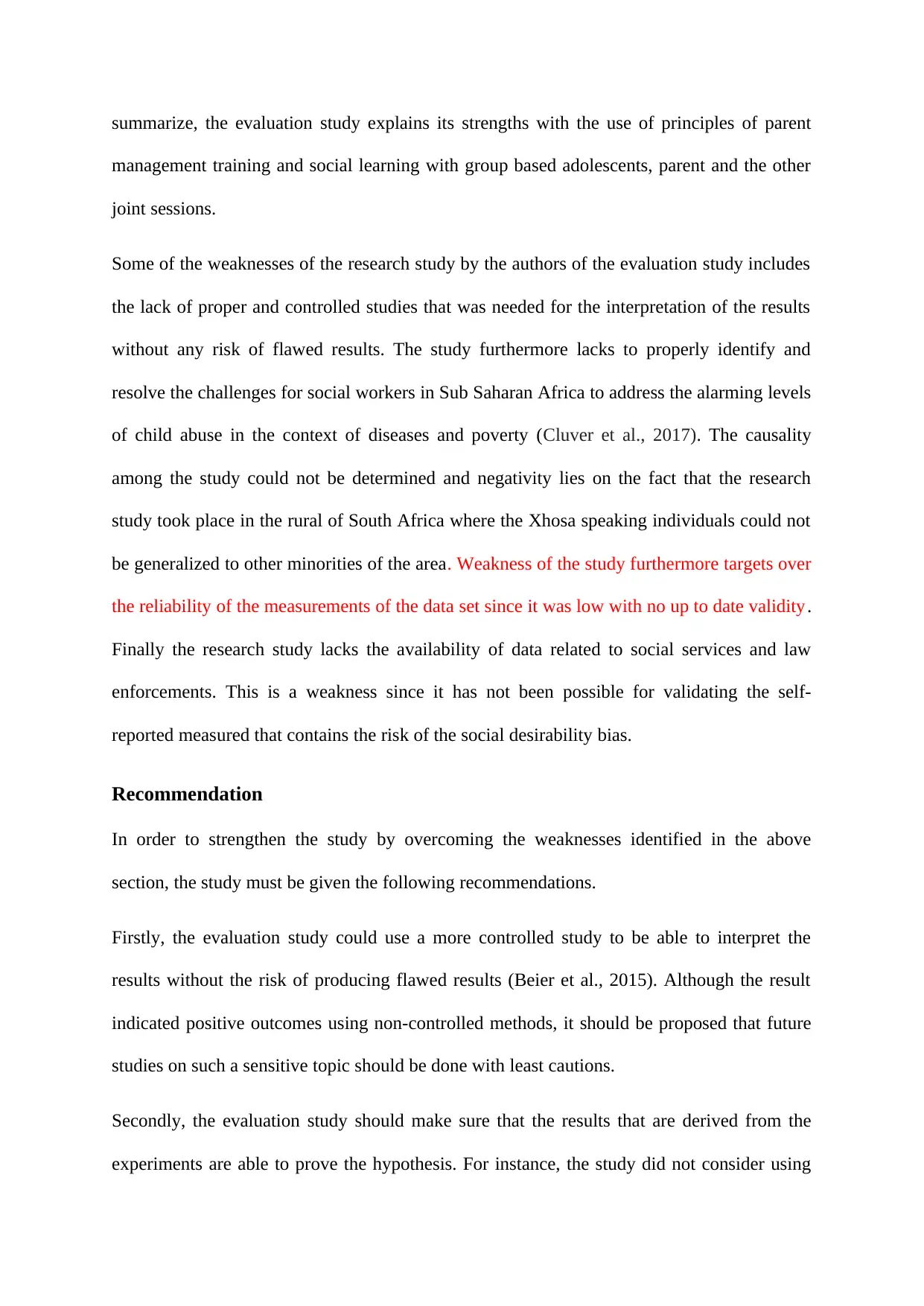
summarize, the evaluation study explains its strengths with the use of principles of parent
management training and social learning with group based adolescents, parent and the other
joint sessions.
Some of the weaknesses of the research study by the authors of the evaluation study includes
the lack of proper and controlled studies that was needed for the interpretation of the results
without any risk of flawed results. The study furthermore lacks to properly identify and
resolve the challenges for social workers in Sub Saharan Africa to address the alarming levels
of child abuse in the context of diseases and poverty (Cluver et al., 2017). The causality
among the study could not be determined and negativity lies on the fact that the research
study took place in the rural of South Africa where the Xhosa speaking individuals could not
be generalized to other minorities of the area. Weakness of the study furthermore targets over
the reliability of the measurements of the data set since it was low with no up to date validity.
Finally the research study lacks the availability of data related to social services and law
enforcements. This is a weakness since it has not been possible for validating the self-
reported measured that contains the risk of the social desirability bias.
Recommendation
In order to strengthen the study by overcoming the weaknesses identified in the above
section, the study must be given the following recommendations.
Firstly, the evaluation study could use a more controlled study to be able to interpret the
results without the risk of producing flawed results (Beier et al., 2015). Although the result
indicated positive outcomes using non-controlled methods, it should be proposed that future
studies on such a sensitive topic should be done with least cautions.
Secondly, the evaluation study should make sure that the results that are derived from the
experiments are able to prove the hypothesis. For instance, the study did not consider using
management training and social learning with group based adolescents, parent and the other
joint sessions.
Some of the weaknesses of the research study by the authors of the evaluation study includes
the lack of proper and controlled studies that was needed for the interpretation of the results
without any risk of flawed results. The study furthermore lacks to properly identify and
resolve the challenges for social workers in Sub Saharan Africa to address the alarming levels
of child abuse in the context of diseases and poverty (Cluver et al., 2017). The causality
among the study could not be determined and negativity lies on the fact that the research
study took place in the rural of South Africa where the Xhosa speaking individuals could not
be generalized to other minorities of the area. Weakness of the study furthermore targets over
the reliability of the measurements of the data set since it was low with no up to date validity.
Finally the research study lacks the availability of data related to social services and law
enforcements. This is a weakness since it has not been possible for validating the self-
reported measured that contains the risk of the social desirability bias.
Recommendation
In order to strengthen the study by overcoming the weaknesses identified in the above
section, the study must be given the following recommendations.
Firstly, the evaluation study could use a more controlled study to be able to interpret the
results without the risk of producing flawed results (Beier et al., 2015). Although the result
indicated positive outcomes using non-controlled methods, it should be proposed that future
studies on such a sensitive topic should be done with least cautions.
Secondly, the evaluation study should make sure that the results that are derived from the
experiments are able to prove the hypothesis. For instance, the study did not consider using
Paraphrase This Document
Need a fresh take? Get an instant paraphrase of this document with our AI Paraphraser
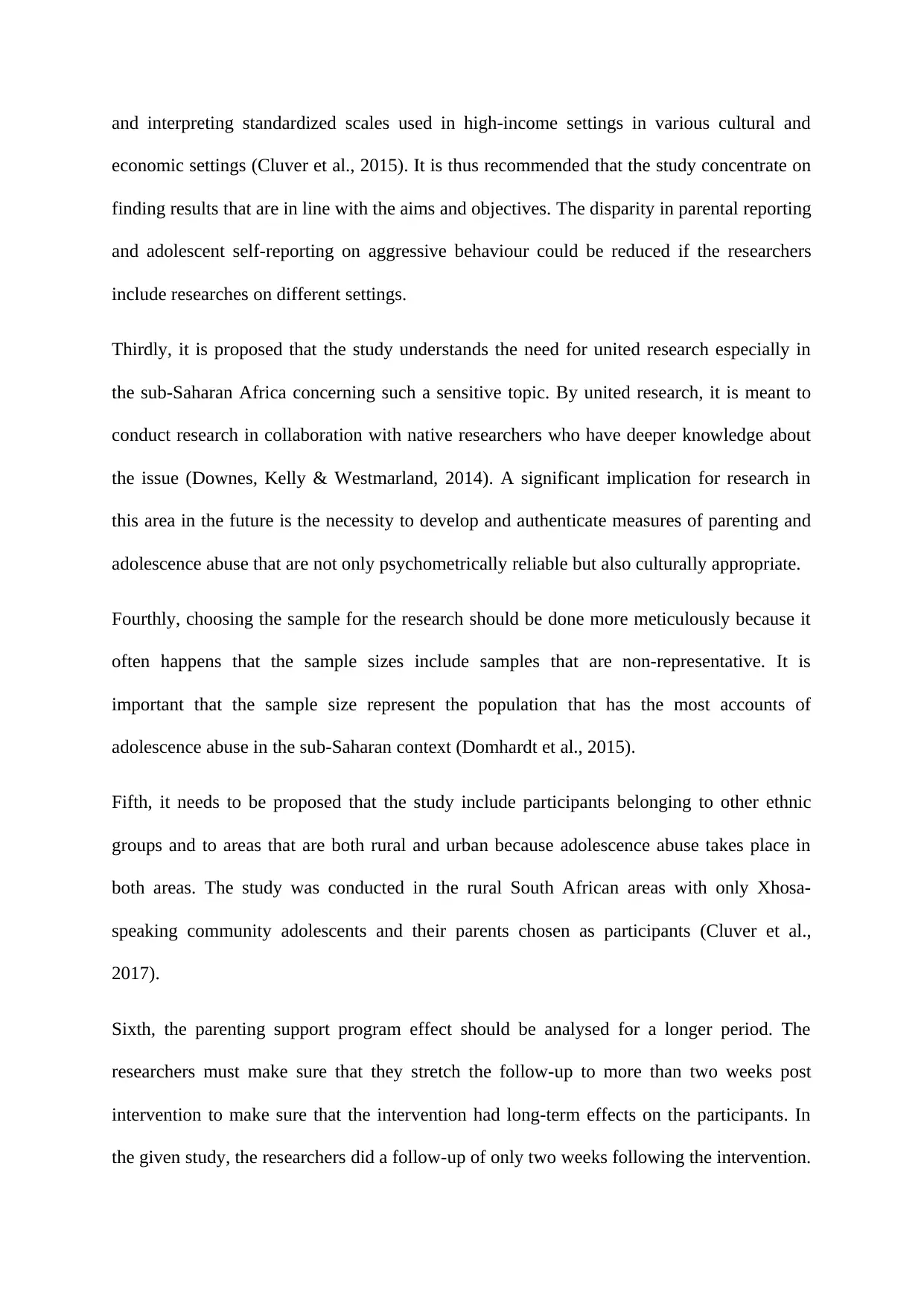
and interpreting standardized scales used in high-income settings in various cultural and
economic settings (Cluver et al., 2015). It is thus recommended that the study concentrate on
finding results that are in line with the aims and objectives. The disparity in parental reporting
and adolescent self-reporting on aggressive behaviour could be reduced if the researchers
include researches on different settings.
Thirdly, it is proposed that the study understands the need for united research especially in
the sub-Saharan Africa concerning such a sensitive topic. By united research, it is meant to
conduct research in collaboration with native researchers who have deeper knowledge about
the issue (Downes, Kelly & Westmarland, 2014). A significant implication for research in
this area in the future is the necessity to develop and authenticate measures of parenting and
adolescence abuse that are not only psychometrically reliable but also culturally appropriate.
Fourthly, choosing the sample for the research should be done more meticulously because it
often happens that the sample sizes include samples that are non-representative. It is
important that the sample size represent the population that has the most accounts of
adolescence abuse in the sub-Saharan context (Domhardt et al., 2015).
Fifth, it needs to be proposed that the study include participants belonging to other ethnic
groups and to areas that are both rural and urban because adolescence abuse takes place in
both areas. The study was conducted in the rural South African areas with only Xhosa-
speaking community adolescents and their parents chosen as participants (Cluver et al.,
2017).
Sixth, the parenting support program effect should be analysed for a longer period. The
researchers must make sure that they stretch the follow-up to more than two weeks post
intervention to make sure that the intervention had long-term effects on the participants. In
the given study, the researchers did a follow-up of only two weeks following the intervention.
economic settings (Cluver et al., 2015). It is thus recommended that the study concentrate on
finding results that are in line with the aims and objectives. The disparity in parental reporting
and adolescent self-reporting on aggressive behaviour could be reduced if the researchers
include researches on different settings.
Thirdly, it is proposed that the study understands the need for united research especially in
the sub-Saharan Africa concerning such a sensitive topic. By united research, it is meant to
conduct research in collaboration with native researchers who have deeper knowledge about
the issue (Downes, Kelly & Westmarland, 2014). A significant implication for research in
this area in the future is the necessity to develop and authenticate measures of parenting and
adolescence abuse that are not only psychometrically reliable but also culturally appropriate.
Fourthly, choosing the sample for the research should be done more meticulously because it
often happens that the sample sizes include samples that are non-representative. It is
important that the sample size represent the population that has the most accounts of
adolescence abuse in the sub-Saharan context (Domhardt et al., 2015).
Fifth, it needs to be proposed that the study include participants belonging to other ethnic
groups and to areas that are both rural and urban because adolescence abuse takes place in
both areas. The study was conducted in the rural South African areas with only Xhosa-
speaking community adolescents and their parents chosen as participants (Cluver et al.,
2017).
Sixth, the parenting support program effect should be analysed for a longer period. The
researchers must make sure that they stretch the follow-up to more than two weeks post
intervention to make sure that the intervention had long-term effects on the participants. In
the given study, the researchers did a follow-up of only two weeks following the intervention.
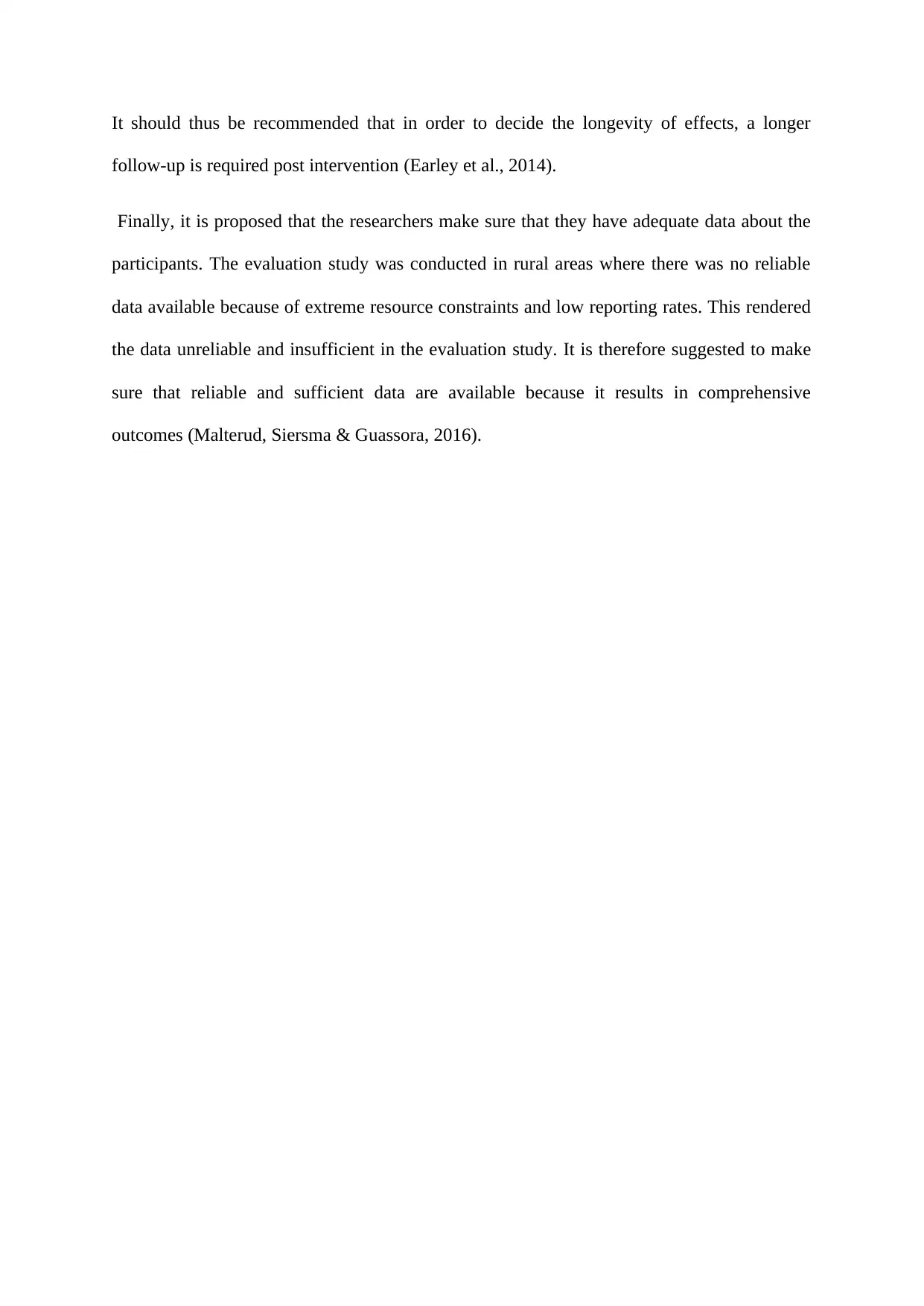
It should thus be recommended that in order to decide the longevity of effects, a longer
follow-up is required post intervention (Earley et al., 2014).
Finally, it is proposed that the researchers make sure that they have adequate data about the
participants. The evaluation study was conducted in rural areas where there was no reliable
data available because of extreme resource constraints and low reporting rates. This rendered
the data unreliable and insufficient in the evaluation study. It is therefore suggested to make
sure that reliable and sufficient data are available because it results in comprehensive
outcomes (Malterud, Siersma & Guassora, 2016).
follow-up is required post intervention (Earley et al., 2014).
Finally, it is proposed that the researchers make sure that they have adequate data about the
participants. The evaluation study was conducted in rural areas where there was no reliable
data available because of extreme resource constraints and low reporting rates. This rendered
the data unreliable and insufficient in the evaluation study. It is therefore suggested to make
sure that reliable and sufficient data are available because it results in comprehensive
outcomes (Malterud, Siersma & Guassora, 2016).
⊘ This is a preview!⊘
Do you want full access?
Subscribe today to unlock all pages.

Trusted by 1+ million students worldwide
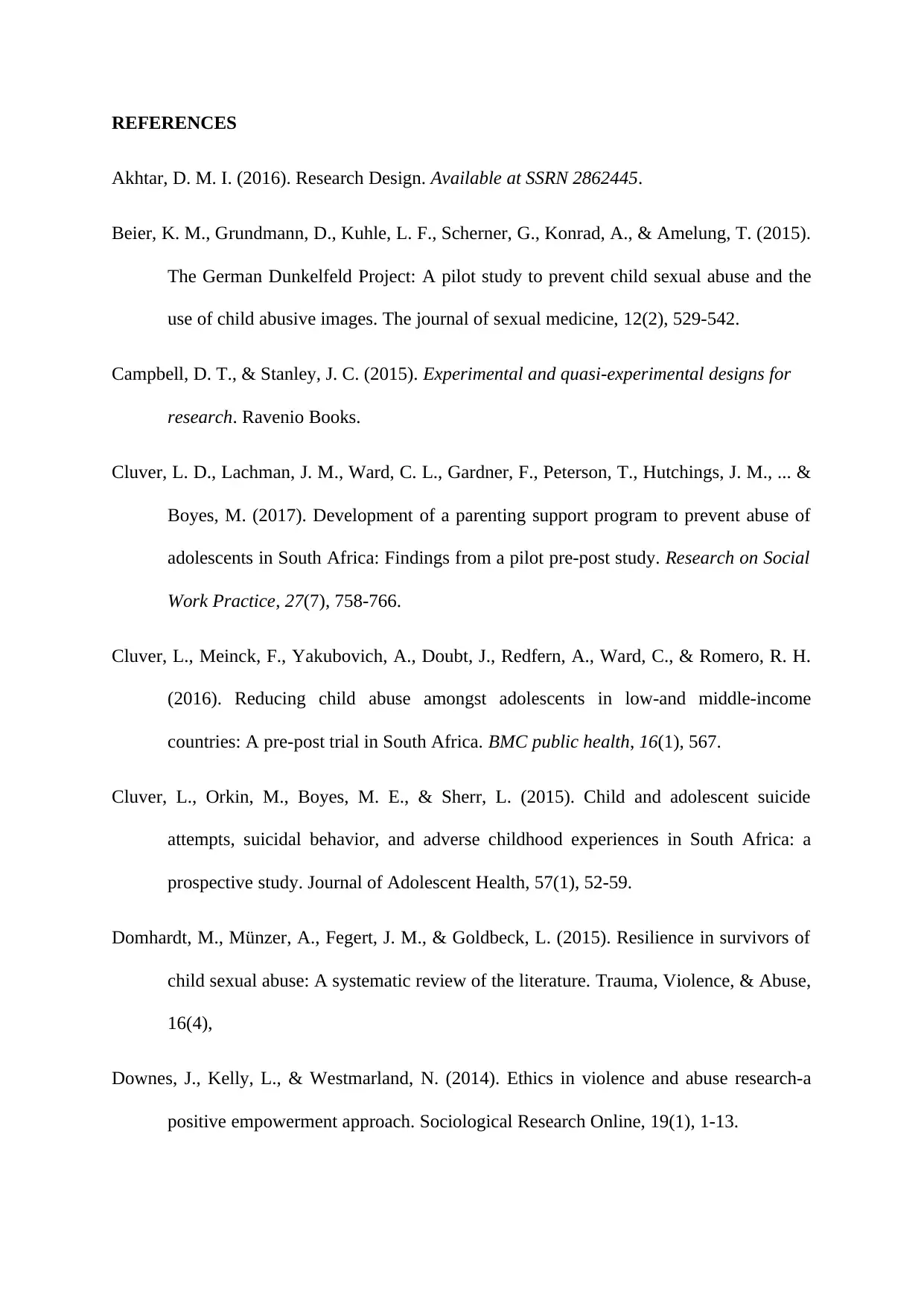
REFERENCES
Akhtar, D. M. I. (2016). Research Design. Available at SSRN 2862445.
Beier, K. M., Grundmann, D., Kuhle, L. F., Scherner, G., Konrad, A., & Amelung, T. (2015).
The German Dunkelfeld Project: A pilot study to prevent child sexual abuse and the
use of child abusive images. The journal of sexual medicine, 12(2), 529-542.
Campbell, D. T., & Stanley, J. C. (2015). Experimental and quasi-experimental designs for
research. Ravenio Books.
Cluver, L. D., Lachman, J. M., Ward, C. L., Gardner, F., Peterson, T., Hutchings, J. M., ... &
Boyes, M. (2017). Development of a parenting support program to prevent abuse of
adolescents in South Africa: Findings from a pilot pre-post study. Research on Social
Work Practice, 27(7), 758-766.
Cluver, L., Meinck, F., Yakubovich, A., Doubt, J., Redfern, A., Ward, C., & Romero, R. H.
(2016). Reducing child abuse amongst adolescents in low-and middle-income
countries: A pre-post trial in South Africa. BMC public health, 16(1), 567.
Cluver, L., Orkin, M., Boyes, M. E., & Sherr, L. (2015). Child and adolescent suicide
attempts, suicidal behavior, and adverse childhood experiences in South Africa: a
prospective study. Journal of Adolescent Health, 57(1), 52-59.
Domhardt, M., Münzer, A., Fegert, J. M., & Goldbeck, L. (2015). Resilience in survivors of
child sexual abuse: A systematic review of the literature. Trauma, Violence, & Abuse,
16(4),
Downes, J., Kelly, L., & Westmarland, N. (2014). Ethics in violence and abuse research-a
positive empowerment approach. Sociological Research Online, 19(1), 1-13.
Akhtar, D. M. I. (2016). Research Design. Available at SSRN 2862445.
Beier, K. M., Grundmann, D., Kuhle, L. F., Scherner, G., Konrad, A., & Amelung, T. (2015).
The German Dunkelfeld Project: A pilot study to prevent child sexual abuse and the
use of child abusive images. The journal of sexual medicine, 12(2), 529-542.
Campbell, D. T., & Stanley, J. C. (2015). Experimental and quasi-experimental designs for
research. Ravenio Books.
Cluver, L. D., Lachman, J. M., Ward, C. L., Gardner, F., Peterson, T., Hutchings, J. M., ... &
Boyes, M. (2017). Development of a parenting support program to prevent abuse of
adolescents in South Africa: Findings from a pilot pre-post study. Research on Social
Work Practice, 27(7), 758-766.
Cluver, L., Meinck, F., Yakubovich, A., Doubt, J., Redfern, A., Ward, C., & Romero, R. H.
(2016). Reducing child abuse amongst adolescents in low-and middle-income
countries: A pre-post trial in South Africa. BMC public health, 16(1), 567.
Cluver, L., Orkin, M., Boyes, M. E., & Sherr, L. (2015). Child and adolescent suicide
attempts, suicidal behavior, and adverse childhood experiences in South Africa: a
prospective study. Journal of Adolescent Health, 57(1), 52-59.
Domhardt, M., Münzer, A., Fegert, J. M., & Goldbeck, L. (2015). Resilience in survivors of
child sexual abuse: A systematic review of the literature. Trauma, Violence, & Abuse,
16(4),
Downes, J., Kelly, L., & Westmarland, N. (2014). Ethics in violence and abuse research-a
positive empowerment approach. Sociological Research Online, 19(1), 1-13.
Paraphrase This Document
Need a fresh take? Get an instant paraphrase of this document with our AI Paraphraser

Earley, M. D., Chesney, M. A., Frye, J., Greene, P. A., Berman, B., & Kimbrough, E. (2014).
Mindfulness intervention for child abuse survivors: A 2.5‐year follow‐up. Journal of
clinical psychology, 70(10), 933-941.
Green, C. A., Duan, N., Gibbons, R. D., Hoagwood, K. E., Palinkas, L. A., & Wisdom, J. P.
(2015). Approaches to mixed methods dissemination and implementation research:
methods, strengths, caveats, and opportunities. Administration and Policy in Mental
Health and Mental Health Services Research, 42(5), 508-523.
Malterud, K., Siersma, V. D., & Guassora, A. D. (2016). Sample size in qualitative interview
studies: guided by information power. Qualitative health research, 26(13), 1753-1760.
Mindfulness intervention for child abuse survivors: A 2.5‐year follow‐up. Journal of
clinical psychology, 70(10), 933-941.
Green, C. A., Duan, N., Gibbons, R. D., Hoagwood, K. E., Palinkas, L. A., & Wisdom, J. P.
(2015). Approaches to mixed methods dissemination and implementation research:
methods, strengths, caveats, and opportunities. Administration and Policy in Mental
Health and Mental Health Services Research, 42(5), 508-523.
Malterud, K., Siersma, V. D., & Guassora, A. D. (2016). Sample size in qualitative interview
studies: guided by information power. Qualitative health research, 26(13), 1753-1760.
1 out of 11
Related Documents
Your All-in-One AI-Powered Toolkit for Academic Success.
+13062052269
info@desklib.com
Available 24*7 on WhatsApp / Email
![[object Object]](/_next/static/media/star-bottom.7253800d.svg)
Unlock your academic potential
Copyright © 2020–2025 A2Z Services. All Rights Reserved. Developed and managed by ZUCOL.





